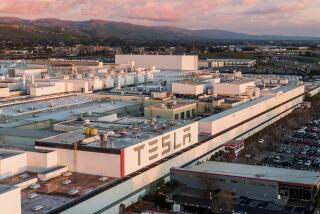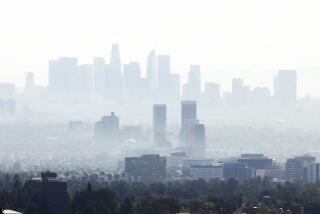Switch from gasoline to ethanol linked to higher smog levels

- Share via
Scientists have made a surprising discovery about ethanol: The more it was used by drivers in Sao Paulo, Brazil, the more ozone they measured in the local environment.
The finding, reported this week in Nature Geoscience, is contrary to other studies predicting that increased use of ethanol would cut levels of ground-level ozone, or smog.
Sao Paulo proved a unique laboratory for studying the effects of ethanol and gasoline usage on local air pollution because 40% of the nearly 6 million light-duty vehicles there can run on either fuel. When the percentage of those vehicles using gasoline rose from 14% to 76%, ambient ozone concentrations in the city fell by about 20%, researchers found.
The study is the first large-scale effort to measure how switching between ethanol and gasoline affects air pollution. It arrives amid a debate in the United States and other industrialized countries over the environmental benefits of ethanol, a renewable fuel made from plant matter.
The study’s authors cautioned against applying the findings from Sao Paulo to other major cities, because an area’s specific climate, vehicle fleet, local industry and traffic patterns all play a role. However, the use of meteorological, economic and air-quality data could serve as a template for studying ethanol’s effect on air pollution elsewhere, the authors said.
“Ozone and nitric oxide are both contributors to urban smog, so depending on how well a city is able to mitigate air pollution, ethanol may not be the ‘green fuel’ that it is often called,” said Franz Geiger, a professor of chemistry at Northwestern University who worked on the study.
Ethanol in Brazil is made from sugar cane, and in Sao Paulo, the fuel is E100, or nearly pure ethanol. In the United States, ethanol is mostly made from corn, and nearly all gasoline sold domestically is 10% ethanol by volume, or E10.
Ethanol use in the U.S. gasoline mix was mandated by Congress in 2007 in an effort to cut greenhouse gas emissions and other pollution, and to reduce reliance on imported oil. (In the coming months, the Environmental Protection Agency is expected to announce how much ethanol needs to be made in 2014 under the national renewable fuel standard.)
But ethanol critics contend that its effect on the environment is as bad or worse than oil. A National Academy of Sciences report concluded that the fossil fuel energy sources used to make ethanol and the amount of land devoted to corn cultivation may make ethanol use “ineffective” in reducing greenhouse gases.
About 40% of the corn cultivated in the U.S. goes to ethanol production. That drives up the price of livestock feed and with it, meat, critics say.
Nearly all studies about the environmental effects of ethanol use have relied on computer simulations or other modeling, and some have raised concerns about its effect on public health, said Emily Cassidy, a biofuels research analyst at the Environmental Working Group. “This [latest] study was great because it has on-the-ground data,” she said.
Gasoline prices in Brazil are controlled by the government, but the price of ethanol fluctuates with the market. When ethanol gets more expensive, drivers opt for gasoline.
Alberto Salvo, an economist with National University of Singapore, realized this presented an opportunity to study what effect, if any, the fuel-switching in Sao Paulo has on the environment.
The largest city in the Southern Hemisphere, Sao Paulo has a temperate climate that does not change substantially in the course of the year. It has “limited industrial activity and residential heating” that could contribute significantly to emissions, Salvo and Geiger wrote in their study, but it has lots of cars and persistent gridlock.
The researchers got fuel-sale information to track consumption trends from 2009 to 2011. Government officials provided data from Sao Paulo’s network of air monitoring stations. The researchers also examined meteorological data and traffic information to take account of other factors that may influence the pollution readings.
The authors said they were “very surprised” to see that ozone concentrations got worse as ethanol use rose. That might be because gasoline produces more nitrogen dioxide emissions, Geiger said. At certain high levels, nitrogen dioxide combines with hydroxyl radicals, a short-lived type of atmospheric chemical that cleans the troposphere of ozone, among other pollutants.
However, gasoline caused other problems, the researchers found: When that fuel became more popular, emissions of carbon monoxide and nitrogen oxide rose. (The authors did not study other pollutants, such as fine particles, which are a focus of their next study.)
Geoff Cooper, senior vice president of research and analysis at the Renewable Fuels Assn., an industry group based in Washington, said the Sao Paulo results were not applicable to the U.S.
“Vehicles in the U.S. must comply with emissions controls requirements that are different (and more stringent) than Brazil,” he said in an email. “Further, the ethanol blend levels examined in the study are unique to Brazil and are not approved in the U.S. Finally, urban ozone formation occurs from rather complex photochemistry that is influenced by a number of factors unique to local climates.”
Salvo acknowledged the differences but said “there’s no reason to think this concern about ozone isn’t worth exploring in communities with blended fuel,” such as the U.S.
Roland Hwang, director of the energy and transportation program at the Natural Resources Defense Council, said the study raised important issues for American policymakers.
“While it’s critical that we reduce our oil dependency, we certainly shouldn’t do it in a way that worsens air quality, water quality and carbon pollution,” he said. “It’s important that we better understand what’s driving these results since the conventional wisdom for decades is that higher blends of ethanol burns cleaner than gasoline.”
Twitter: @neelaeast







